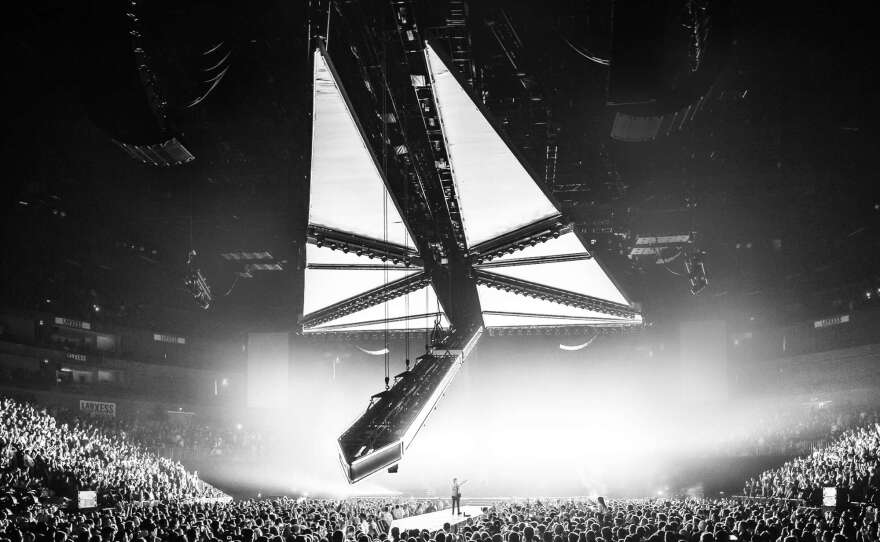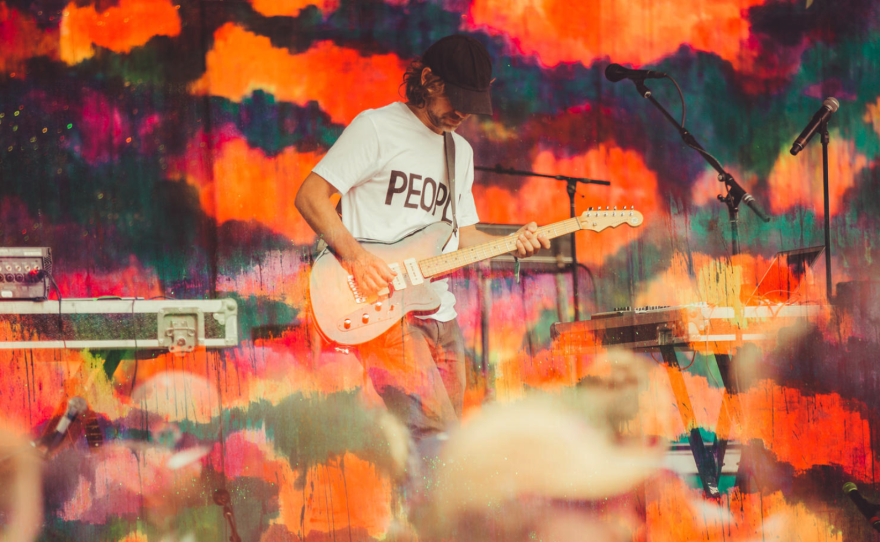Music is about connection—rhythms resemble the beat of a heart, energy flows like blood in our veins, poetry stirs the soul—a reminder that we are alive and we are not alone.
The communal experience of live music relies on a sense of intimacy between artist and audience. But, how do you achieve that in a large venue? How do you heighten and redefine the concert experience? And, in the digital age, how and when do you embrace technology? When do you reject it? These are the questions facing today's top stage designers.
From Es Devlin and Willie Williams’ cutting-edge production for U2’s new arena tour, to the complex choreography that David Byrne brought to the Riverside Theater, to the immersive elements of the Eaux Claires festival, to the hand-painted installations of local creative Kristina Rolander, modern stage designers are deepening the connections between musicians and fans through innovative artistry.
U2 redefines the fourth wall
U2 has been at the forefront of the music industry for decades. This is partly due to the fact that the iconic Irish rock band has worked with the same creative director—Willie Williams—since 1982.
“That’s probably the reason why U2’s stage sets are some of the best, because they’ve had that continuity of practice in saying this is an art form we want to develop,” designer Es Devlin said in a recent interview.
In 2014, Devlin joined Williams and Stufish Studios to create U2’s 2015 iNNOCENCE + eXPERIENCE Tour. Earlier this month, they unveiled the companion eXPERIENCE + iNNOCENCE Tour for 2018.
Last week, I went to Chicago for the first of two shows at the United Center where U2 completely redefined the fourth wall by incorporating augmented reality into their stage design.
U2's eXPERIENCE + iNNOCENCE Tour
The night began with a giant glacier melting in the middle of the arena. No one actually got wet though, as the glacier could only be seen through an augmented reality feature on the tour’s smartphone app. This technology truly shined during the opening song, when my phone showed a huge avatar of Bono towering above the singer, whose performance was being replicated by the avatar.
Augmented reality reappeared once more during the show, though not through the app. A cartoon devil face was superimposed on Bono, which was projected on an 80-foot, double-sided, transparent LCD screen that band members walked into.
The screen displayed a variety of stunning visuals and allowed for interplay with the musicians. A particularly poignant moment occurred when a home video clip of Bono’s mother—who died tragically when he was 14—was looped to match a memory the singer had mentioned while introducing the song.
“I’m trying to put blood into the zeros and the ones,” Bono recentlytold CNN. “We’re trying to break the fourth wall to get to our audience, to reach them.”
‘Architect of temporary space’
Considering U2’s emphasis on visual narrative, it comes as no surprise that they tapped Es Devlin. The decorated British designer emerged from—and still works in—the world of theater and opera. When collaborating with musicians, Devlin applies textual analysis to their lyrics, which informs her stage design.
She says, “The goal is to break down the barrier of people expecting to just see music on stages. It’s about how different genres of art can come together and blur the lines between each other.”
It’s about how different genres of art can come together and blur the lines between each other.
Devlin’s career was catapulted when Kanye West commissioned her to design his 2008 Glow in the Dark Tour. Described as “an architect of temporary space,” Devlin has since worked with The Weeknd, Adele, Beyoncé, The Rolling Stones and three of the biggest pop shows to play the Bradley Center in recent years: Miley Cyrus (2014), Katy Perry (2017) and Lorde (2018).
Since Devlin began working with musicians, cell phone cameras have become ubiquitous. She is hyper-aware of this reality and strives for designs that can be photographed from every angle. In this way, Devlin sees the audience as “participants in a sculptural portrait.”
The creative minds behind Eaux Claires
Like Devlin, Michael Brown is a designer who began his career in theater and aims to dismantle the wall between artist and audience. As creative director of the Eaux Claires festival, Brown has worked closely with Aaron Dessner of The National and Justin Vernon of Bon Iver to upend preconceptions surrounding the festival experience.
Eaux Claires sets itself apart by emphasizing collaboration among musicians, incorporating immersive and interactive installations and fostering an open-minded community.
“You’re not going to be able to go in and change all the language in year one,” Brown said in a 2015 interview. “But, hopefully, this community we’re creating will keep learning with us and we can keep pushing it further and further, until maybe 10 years from now, this different format has been created.”
This year, Eaux Claires took a big step in that direction by choosing not to release a lineup for the fourth installment of the festival.
“It’s not about the bands, it’s about the collection of art and artists reacting with the collection of you,” the Eaux Claires website reads. “We’re less interested in telling you what it is than you making it what it becomes.”
"For Emma, Ten Year" stage at the Bradley Center
As far as albums go, it doesn’t get much more intimate than Bon Iver’s 2007 breakthrough, "For Emma, Forever Ago," written by Justin Vernon while he was alone in the woods.
When Vernon decided to stage a one-off, 10-year anniversary show, the Bradley Center seemed an odd choice. Michael Brown was tasked with invoking the feeling and intimacy of that time. He collaborated with the artist Erin Murphy for a stage design described as “candle wax meets ice,” which was brilliantly brought to life by video director Ben Krall and Turtle LX lighting.
'Lo-fi magic' from Milwaukee
For Michael Brown, Eaux Claires is an unique avenue for artistic expression because it allows him to gather together a variety of artists to collaborate on one expansive project.
Local creative Kristina Rolander was among those chosen for Eaux Claires 2017. A graduate of the Milwaukee School of Art and Design (MIAD), Rolander first combined her love of music and installation art for WebsterX’s Milwaukee Day performance at Turner Hall Ballroom in 2015.
Rolander creates large-scale paintings and immersive environments, occasionally collaborating with local video artist Wes Tank. Rolander cites Milwaukee artists Video Villains and Bread Mothers as inspirations, as well as Michael Brown and Es Devlin.
“I felt an immediate kinship with Es when I learned about her work," says Rolander. "Like her, I’m trying to transform ordinary space by uniting art, audience and performer in a singular, transcendent experience."
Rolander’s custom stage design has been on display at the Cactus Club in Bay View since April 2017. Earlier this year, she was commissioned to create the stage design for spoken word artist Andrea Gibson’s international tour. Later this summer, Rolander’s “lo-fi magic” will be featured at the Up Here festival in Sudbury, Ontario—her second Canadian festival of the year.
David Byrne goes beyond dance moves
David Byrne started with a simple idea for his latest stage production. Inspired by the mobile horn players from his tour with St. Vincent, Byrne’s team managed to make all the musicians mobile for this year's American Utopia Tour, including a six-piece percussion unit that reproduces the sound of a full drum kit. Then, he hired the choreographer Annie-B. Parson.
“Although she might be listed as a choreographer, it goes a little bit beyond that,” Byrne said in a recent interview. “It’s more about staging; it’s not just about the dance moves.”
Parsons’ work was matched with dramatic lighting, creating a compelling shadow play set against elegant metal chain “curtains” that outline the stage. Their recent Riverside Theater performance garnered rave reviews, serving as a testament to what can be done with stage design without video screens.
The future of the concert experience in the digital age
While some musicians, like Jack White, would rather prohibit cell phones and perform on a barren stage, many others are utilizing technology and visual art to enhance the concert experience and deepen the connection with their audience.
In a few short months, Milwaukee will have a new state-of-the-art arena designed for both sports and live music. The future is bright for innovative, large-scale concerts in our own backyard. Fingers crossed for the next U2 tour.
























































































































